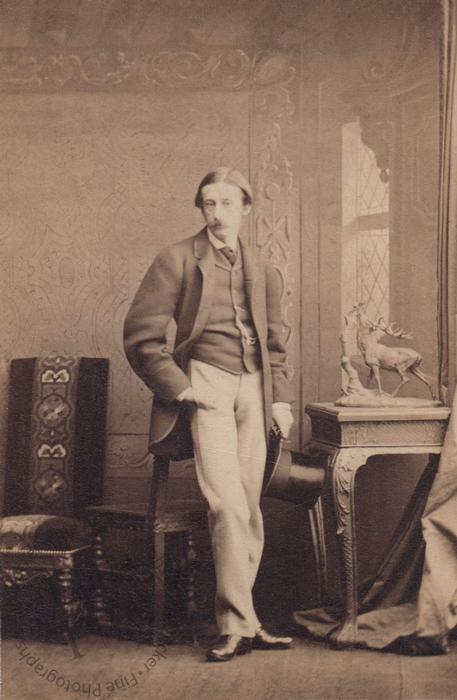Augustus Hare
(1834-1903)
9 February 1862
Volume 6, page 31, sitting number 6994.
Augustus John Cuthbert Hare was born into an aristocratic English family, most of whose members were peculiar, to say the least. He survived a childhood of Dickensian cruelty to write a six-volume autobiography, The Story of My Life, as well as many monumental travel guides which survived for decades, all liberally peppered with amusing anecdotes. In spite of his literary success, he was nevertheless often short of funds, but he 'collected cousins as others collect stamps' and could always find a country house to put him up, where his abilities as a raconteur made him a welcome guest.
His writings fall chiefly into two categories, biographies of the members and connections of his family, and descriptive and historical accounts of various cities and countries. His texts include a lively description of Mark Twain, a report on Thomas Carlyle complete with Scottish accent, tales of ghosts, and complaints about his publisher. His extraordinary account of the man who kept marrying women with a wooden leg is perhaps his most entertaining, while the tale of the Croglin Grange vampire can still make the blood chill. He is sometimes claimed as the author of the longest autobiography in the world.
He died in Rome the day after he heard of the death of his life-long friend Mme Ernest Bunsen, and was buried in the Protestant cemetery.
An incomplete bibliography: Epitaphs from Country Churchyards (1856), Walks in Rome (1871), Memorials of a Quiet Life, a biography of his aunt Maria Hare (1872), Wanderings in Spain (1873), Days Near Rome (1875), Cities of Northern and Central Italy (1876), Walks in London (1878), Cities of Southern Italy and Sicily (1883), Cities of Central and Northern Italy (1884), Venice (1884), Studies in Russia (1885), Sketches in Holland and Scandinavia (1885), Paris (1887), North-Eastern France (1890), South-Eastern France (1890), South-Western France (1890), Story of Two Noble Lives, the lives being those of Charlotte, Countess Canning, and Louisa, Marchioness of Waterford (1893), Sussex (1894), and Life and Letters of Maria Edgeworth (1894).
This is Hare writing on his childhood:
'[...] my mother gave in to a suggestion of Aunt Esther that I should be locked into the vestry of the church between the services. Miserable indeed were the three hours which - provided with a sandwich for dinner - I had weekly to spend there; and though I did not expect to see ghosts, the utter isolation of Hurstmonceaux Church, far away from all haunts of men, gave my imprisonment an unusual eeriness. Sometimes I used to clamber over the tomb of the Lords Dacre, which rises like a screen against one side of the vestry, and be stricken with vague terrors by the two grim white figures lying upon it in the silent desolation, in which the scamper of a rat across the floor seemed to make a noise like a whirlwind. At that time two grinning skulls (of the founder and foundress of the church, it was believed) lay on the ledge of the tomb; but soon after this Uncle Julius and Aunt Esther made a weird excursion to the churchyard with a spade, and buried them in the dusk with their own hands. In the winter holidays, the intense cold of the unwarmed church made me so ill, that it led to my miserable penance being remitted.'

